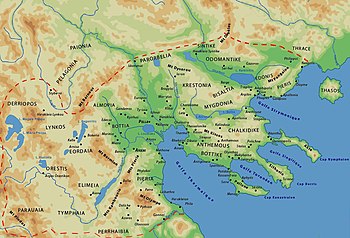
Oesyme or Oisyme (Attic Greek: Οἰσύμη, Doric Greek: Οἰσύμα) and Aisyme or Aesyme (Ancient Greek: Αἰσύμη) was an ancient Greek polis (city-state) located in ancient Thrace and later in Macedonia. It was within the region of Pieras or Edonis between the river Strymon and the river Nestos.
Thucydides mentions it with Galepsus and notes that both were colonies of Thasos that sided with the Spartan army of Brasidas after it had taken Amphipolis in 424 BCE. Stephanus of Byzantium identifies it as the same Aesyme or Aisyme (Αίσύμη) named by Homer in the Iliad as the place of origin of Castianeira, mother of Gorgythion, who was fathered by Priam, king of Troy.
The town is mentioned by several ancient geographers including Ptolemy and Pliny the Elder. Diodorus notes the town under the misspelling Σύμη - Syme (omitting the initial vowels). The town also appears in the Periplus of Pseudo-Scylax as Σιούμη - Sioume. It is also mentioned in the Delphic Theorodochoi inscription. It was later renamed to Emathia (Ἠμαθία) after its occupation by Philip II of Macedon. According to Pseudo-Scymnus, it was named Emathia after the daughter of Makesse. It was considered a polis and an emporion at the same time.
Athenaeus quotes a passage from Armenidas where Oesyme is mentioned among the places of Thrace famous for the quality of their wines.
It is also mentioned in the Lexicon of the Ten Orators and the Suda.
The location of the ancient city is identified with the fortified citadel on Cape Vrasidas south of the village of Nea Peramos in the southern part of the bay of Eleutherai.
See also
References
- ^ Mogens Herman Hansen & Thomas Heine Nielsen (2004). "Thrace from Strymon to Nestos". An inventory of archaic and classical poleis. New York: Oxford University Press. p. 864. ISBN 0-19-814099-1.
- Thucydides. History of the Peloponnesian War. Vol. 4.107.
- Homer. Iliad. Vol. 8.304.
- Ptolemy. The Geography. Vol. 3.13.9.
- Pliny. Naturalis Historia. Vol. 4.18.
- Diodorus Siculus. Bibliotheca historica (Historical Library). Vol. 12.68.
- ^
 Smith, William, ed. (1854–1857). "Oesyme". Dictionary of Greek and Roman Geography. London: John Murray.
Smith, William, ed. (1854–1857). "Oesyme". Dictionary of Greek and Roman Geography. London: John Murray.
- Periplus of Pseudo-Scylax, 67.
- Delphic Theorodochoi Inscription, 81
- Pseudo Scymnus or Pausanias of Damascus, Circuit of the Earth, 646
- Athenaeus, Deipnosophistae I, 31a.
- Lexicon of the Ten Orators, o12
- Suda, oi.184
- Richard Talbert, ed. (2000). Barrington Atlas of the Greek and Roman World. Princeton University Press. p. 51, and directory notes accompanying. ISBN 978-0-691-03169-9.
- Lund University. Digital Atlas of the Roman Empire.
![]() This article incorporates text from a publication now in the public domain: Smith, William, ed. (1854–1857). "Oesmye". Dictionary of Greek and Roman Geography. London: John Murray.
This article incorporates text from a publication now in the public domain: Smith, William, ed. (1854–1857). "Oesmye". Dictionary of Greek and Roman Geography. London: John Murray.
40°49′25″N 24°19′21″E / 40.823715°N 24.322529°E / 40.823715; 24.322529
This article about a location in ancient Thrace is a stub. You can help Misplaced Pages by expanding it. |